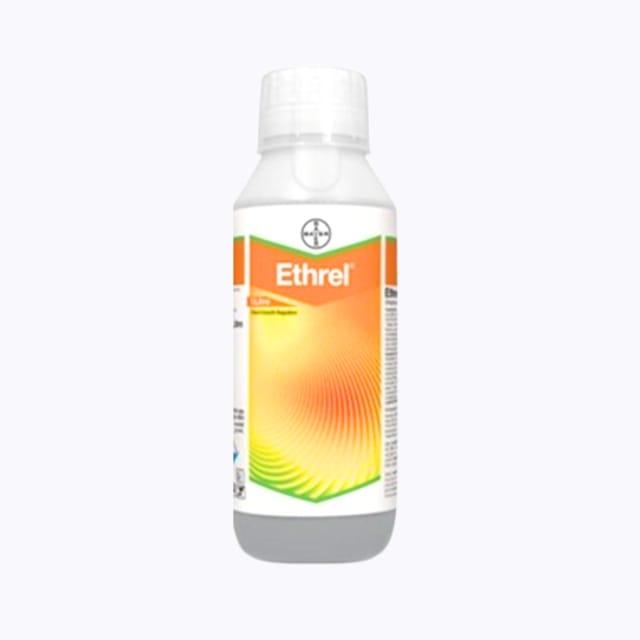₹1,210₹1,570
₹670₹739
₹1,449₹1,935
₹3,079₹3,390
₹379₹445
₹1,390₹1,900

MRP ₹1,800 Inclusive of all taxes
Bayer Ethrel Plant Growth Promoter is a versatile plant growth regulator that enhances fruit coloration, accelerates uniform ripening, and induces flowering in a variety of crops such as mango, pineapple, tomato, and more. It can also be used for defoliation in pomegranate and breaking alternate bearing tendencies in mango, making it a crucial tool for improved crop management and productivity.
| Specification | Details |
|---|---|
| Brand | Bayer |
| Technical Content | Ethephon 39 SL (39% w/w) |
| Dosage | 1-2.5 ml/liter of water or 200-500 ml/acre |
| Target Crops | Mango, Pineapple, Tomato, Coffee, Rubber, Pomegranate |
Ethrel acts as a systemic plant growth regulator. Once it penetrates plant tissues, it decomposes into ethylene, which influences several physiological processes, including ripening, flowering, and defoliation. This action ensures uniformity in fruit ripening and flowering, as well as improving crop health and yield.
| Crop | Purpose | Application |
|---|---|---|
| Mango | Breaking alternate bearing tendencies | First spray in mid-October or early November, total 5 sprays at fortnightly intervals. |
| Mango | Flower induction | Start in early November, 5 weekly sprays for optimal results. |
| Mango | Post-harvest treatment | Dip mature fruits in a solution for uniform ripening (one treatment required). |
| Pineapple | Flower induction | Apply at the 30-37 leaf stage or 10-12 months. One spray required. |
| Coffee (Arabica/Robusta) | Uniform ripening of berries | Spray once at the fly-picking stage when 10-15% of berries are ripened. |
| Tomato | Post-harvest treatment | One dip treatment post-harvest for uniform ripening. |
| Rubber | Yield enhancement | Brush the solution on the tapping cut of the bark in March, August, September, and November (four applications). |
| Pomegranate | Defoliation for better flowering & fruit yield | Apply for defoliation to induce better flowering and increase fruit yield. |
| Crop | Dosage (ml/liter) | Dosage (ml/acre) |
|---|---|---|
| Mango | 1-2.5 ml/liter | 200-500 ml/acre |
| Pineapple | 1-2.5 ml/liter | 200-500 ml/acre |
| Coffee | 1-2.5 ml/liter | 200-500 ml/acre |
| Tomato | 1-2.5 ml/liter | 200-500 ml/acre |
| Rubber | 1-2.5 ml/liter | 200-500 ml/acre |
| Pomegranate | 1-2.5 ml/liter | 200-500 ml/acre |
Q: How does Ethrel promote ripening?
A: Ethrel decomposes into ethylene within the plant, which accelerates the ripening process and improves fruit coloration.
Q: What is the recommended dosage for mango flower induction?
A: For flower induction in mango, apply 1-2.5 ml per liter of water, with 5 sprays at weekly intervals starting from early November.
Q: Can Ethrel be used for post-harvest treatments?
A: Yes, Ethrel can be used for post-harvest treatments in crops like mango and tomato by dipping fruits in the solution for uniform ripening.
Q: Is Ethrel suitable for use in rubber plantations?
A: Yes, Ethrel is effective in rubber plantations, where it is applied to increase latex yield by brushing the solution on the tapping cut of the bark.
Q: How often should Ethrel be applied for breaking alternate bearing in mango?
A: To break alternate bearing tendencies in mango, apply a total of 5 sprays starting mid-October or early November, with fortnightly intervals.
